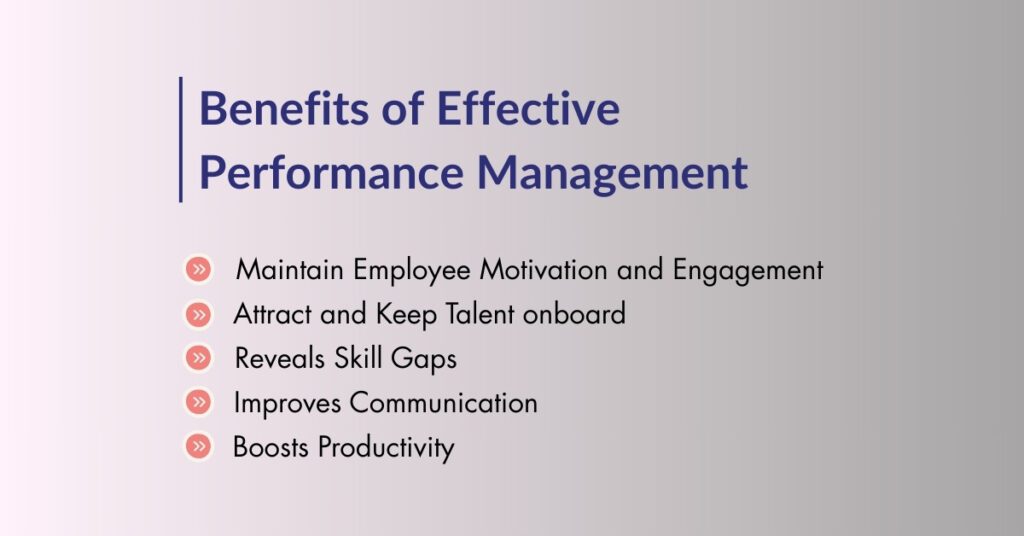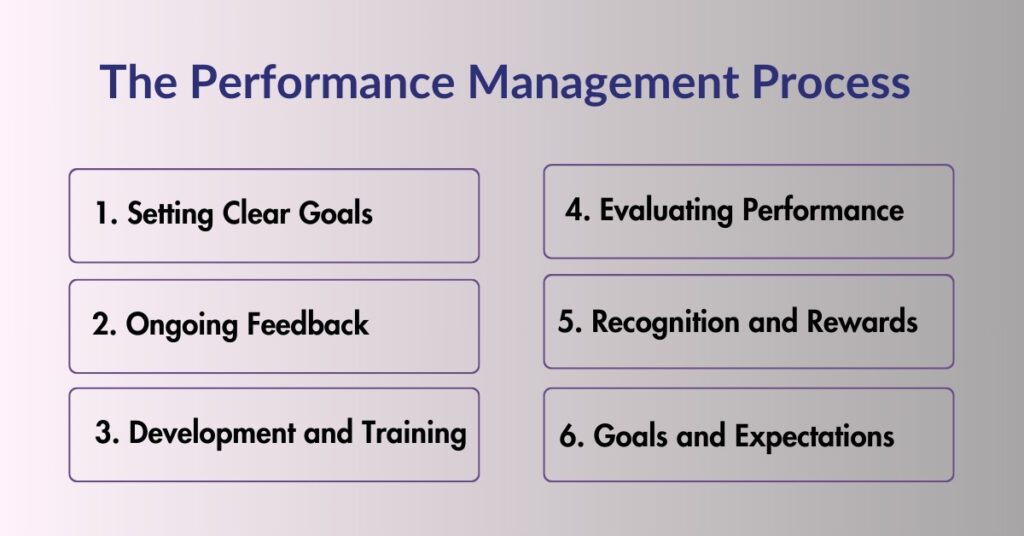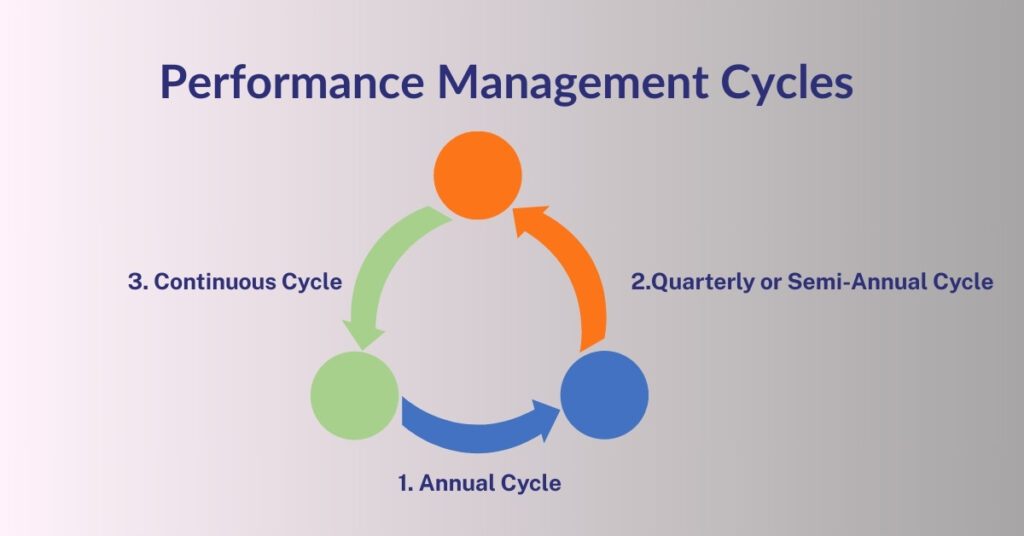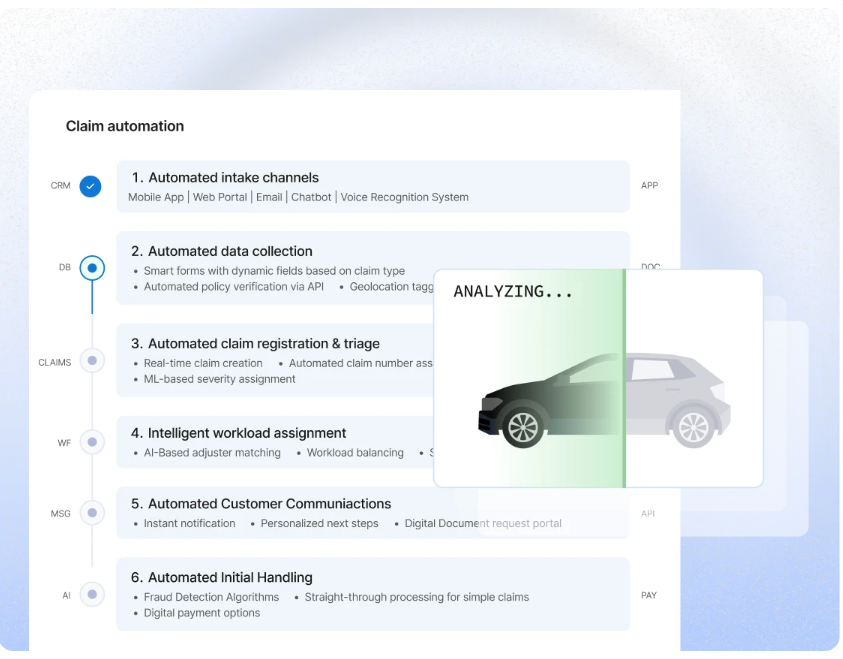Performance management System is an ongoing conversation between managers and employees.
Performance Management is about looking at how someone is doing in their role, sharing feedback, and setting clear goals for the future.
While most people think of the yearly performance review, that’s just one piece of the puzzle.
By improving how you manage performance, you can keep your team more engaged and motivated, which usually means they’ll get more done.
In this post, we will explain some easy-to-follow performance management tips to help your team do their best work.
Table of contents

What Is Performance Management?
Performance management is about helping employees to grow and thrive at work.
Performance Management is an ongoing practice where managers and team members communicate about goals, provide feedback and make plans to meet those objectives.
Instead of holding annual meetings, ongoing dialogue can help build trust, increase teamwork, and support everyone’s development.
Benefits of Effective Performance Management

Effective performance management goes beyond checking boxes; it should focus on building strong bonds among team members and helping them thrive.
Here are some of the key benefits:
1. Maintain Employee Motivation and Engagement
People want to feel valued in their jobs. When managers provide regular and meaningful feedback to employees, employees feel more supported and are more likely to do their best work.
2. Attract and Keep Talent onboard
Employees who feel valued and appreciated are less likely to leave, while having an outstanding performance management program can attract top talent.
3. Reveals Skill Gaps
Ongoing discussions regarding employee performance can reveal areas in need of additional training or support, which helps plan for growth and professional development.
4. Improves Communication
Good performance management relies on effective, open communication. If expectations are clear, everyone knows where they stand and what’s coming next.
5. Boosts Productivity
Performance management helps employees work more effectively, which increases team productivity overall.
The Performance Management Process

Performance management processes consist of several steps designed to assist organizations in monitoring and improving employee performance. Here’s an overview of this process:
1. Setting Clear Goals:
The first step of performance management involves setting specific and measurable goals for employees that align with company goals. More specific goals make tracking progress simpler.
2. Ongoing Feedback:
Provide regular and constructive feedback to employees on what they’re doing well and where there is room for improvement; be it clear, honest or motivational in nature.
3. Development and Training:
Employees should have opportunities to build their skills through training programs. This helps improve performance and adapt to new challenges more readily.
4. Evaluating Performance:
Regular reviews help evaluate whether employees are meeting their goals effectively.
Evaluation can take place quarterly, semi-annually or annually and should identify both strengths and areas for development.
5. Recognition and Rewards:
Acknowledging hard work and achievements boosts morale and motivates employees, increasing morale while motivating them. Acknowledging employees may take the form of thank-you bonuses, promotions or other incentives.
6. Adjustment of Goals and Expectations:
If performance doesn’t meet expectations, managers may make necessary adjustments or provide additional resources or training, so employees have everything they need for success.
Performance Management Cycles

Performance management cycles refer to the recurring timeline in which performance is reviewed and improved. These cycles can vary, but here are the common types:
1. Annual Cycle:
The most traditional cycle where performance reviews are conducted once a year. Employees and managers set yearly goals, and performance is evaluated at the end of the year.
2. Quarterly or Semi-Annual Cycle:
Some companies prefer a more frequent cycle of performance evaluations every quarter or every six months. This allows for more regular feedback and adjustments to goals.
3. Continuous Cycle:
This cycle is less structured and focuses on ongoing feedback throughout the year. Managers continuously check in with employees, set and review goals, and provide feedback as needed.
The Role of Goals in Performance Management
Setting the right goals is essential for employee motivation and alignment with company objectives.
Here’s why goals are so important in performance management:
- Clarity: Well-defined goals help employees understand what is expected of them.
- Motivation: Clear goals inspire employees to put in the effort needed to succeed.
- Focus: Goals help prioritize tasks and eliminate distractions, ensuring employees focus on what truly matters.
- Tracking Progress: Goals act as milestones that managers and employees can track to measure success.
Examples of goals might include increasing sales by 10%, improving customer satisfaction scores, or completing a project by a certain date.
Best Practices for Effective Performance Management
Want to make your performance management process more effective? Here are some simple best practices that can really help:
1. Set Clear Expectations
Start by making sure employees know exactly what’s expected of them.
When people understand their goals and how their performance will be measured, they’re more likely to stay on track and succeed.
2. Be Flexible with Goals
Things change and so should goals when needed. If your business priorities shift, make sure your team’s goals are updated to reflect that.
Tracking the right metrics can help you decide when it’s time to make those changes.
3. Give Regular Feedback
Don’t wait for the yearly review. Give feedback often both when someone does a great job and when they need to improve. This helps employees grow and stay motivated.
4. Offer Support and Tools
Employees do better when they have the right resources. That could be training, coaching, or mentoring. Helping your team build their skills shows you’re invested in their success.
5. Use Technology to Make It Easier
Performance management tools can help you track goals, give feedback, and review performance more easily. It saves time and keeps everything organized.
6. Keep Improving the Process
Even if your current system works, there’s always room to grow. Stay open to new ideas and ways to make your performance management approach even better over time.
Examples of Performance Management Systems
Several tools and systems can be used to manage performance effectively.
Here are a few examples:
1. OKRs (Objectives and Key Results):
A popular system for setting and tracking goals. OKRs align individual and company goals, allowing employees to focus on measurable outcomes.
2. 360-Degree Feedback:
This system gathers feedback from a variety of sources: managers, peers, and even customers. It gives a holistic view of an employee’s performance and helps identify areas for improvement.
3. Balanced Scorecard:
This tool evaluates performance in multiple areas financial, customer, internal processes, and learning and growth. It ensures employees focus on different aspects of their performance, not just one.

Conclusion
Performance management is not just about evaluating past work; it’s about fostering growth, providing regular feedback, and ensuring that employees are aligned with the organization’s objectives.
Whether through annual reviews, continuous feedback, or SMART goals, the goal is to create a system where everyone can succeed and thrive.
By following best practices and focusing on clear goals, performance management can be a powerful tool for improving both individual and organizational success.
FAQs
Performance reviews should ideally be done at least once a year, but many companies prefer quarterly or semi-annual reviews for more timely feedback.
Performance management is an ongoing process of setting goals and giving feedback, while performance appraisal is a specific review event that evaluates an employee’s performance.
Yes, many companies use software tools to automate parts of the performance management process, such as goal tracking, feedback collection, and performance reviews.
Feedback helps employees understand their strengths and areas for improvement, making it essential for growth and development.
Tools like OKRs, 360-degree feedback, and Balanced Scorecards are commonly used to manage employee performance and set clear, measurable goals.








